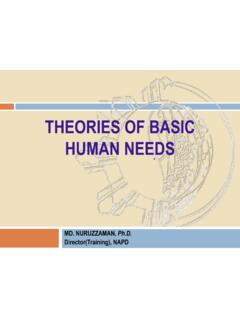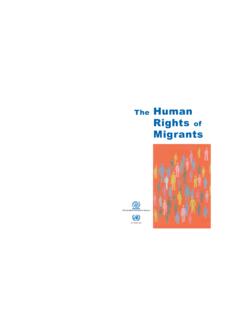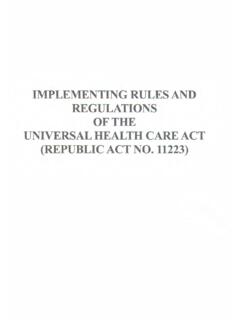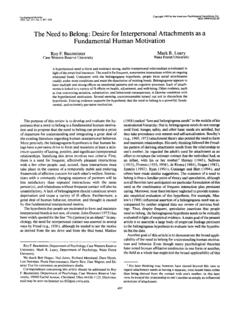Transcription of IILOLO-OOSH 2001SH 2001
1 Guidelines on occupational safetyGuidelines on occupational safetyand health management systemsand health management systemsILOILO--OSH 2001 OSH 2001 At the onset of the twenty-first century, a heavy human and economic toll is still exacted by unsafe and unhealthy working conditions. The Guidelines call for coherent policies to protect workers from occupational hazards and risks while improving productivity. They present practical approaches and tools for assisting organizations, competent national institutions, employers, workers and other partners in establishing, implementing and improving occupational safety and health management systems, with the aim of reducing work-related injuries, ill health, diseases, incidents and deaths.
2 The Guidelines may be applied on two levels national and organizational. At the national level, they provide for the establishment of a national framework for occupational safety and health (OSH) management systems, preferably supported by national laws and regulations. They also provide precise information on developing voluntary arrangements to strengthen compliance with regulations and standards, which, in turn, lead to continual improvement of OSH performance. At the organizational level, the Guidelines encourage the integration of OSH management system elements as an important component of overall policy and management arrangements.
3 Organizations, employers, owners, managerial staff, workers and their representatives are motivated in applying appropriate OSH management principles and methods to improve OSH performance. Employers and competent national institutions are accountable for and have a duty to organize measures designed to ensure occupational safety and health. The implementation of these ILO Guidelines is one useful approach to fulfi lling this : 20 Swiss francsINTERNATIONAL LABOUR occupationalsafety and healthmanagementsystemsILO-OSH 2001(Second Edition*)*This second edition includes additions made by the Office to the bibliography which are indicated with an asterisk (*).
4 Guidelineson occupationalsafety and healthmanagementsystemsILO-OSH 2001 INTERNATIONAL LABOUR Guidelines on occupational safety and health management systemsCopyright International Labour Organization 2001 First published 2001 Second edition 2009 Publications of the International Labour Office enjoy copyright under Protocol 2 of the Universal Copyright Convention. Never-theless, short excerpts from them may be reproduced without authorization, on condition that the source is indicated. For rightsof reproduction or translation, application should be made to the Publications Bureau (Rights and Permissions), InternationalLabour Office, CH-1211 Geneva 22, Switzerland.
5 The International Labour Office welcomes such , institutions and other users registered in the United Kingdom with the Copyright Licensing Agency, 90 TottenhamCourt Road, London W1T 4LP [Fax: (+44) (0)20 7631 5500; email: in the United States with the CopyrightClearance Center, 222 Rosewood Drive, Danvers, MA 01923 [Fax: (+1) (978) 750 4470; email: or in othercountries with associated Reproduction Rights Organizations, may make photocopies in accordance with the licences issued tothem for this designations employed in ILO publications, which are in conformity with United Nations practice, and the presentation ofmaterial therein do not imply the expression of any opinion whatsoever on the part of the International Labour Office concerningthe legal status of any country, area or territory or of its authorities, or concerning the delimitation of its responsibility for opinions expressed in signed articles, studies and other contributions rests solely with their authors.]]
6 Andpublication does not constitute an endorsement by the International Labour Office of the opinions expressed in them. Reference to names of firms and commercial products and processes does not imply their endorsement by the InternationalLabour Office, and any failure to mention a particular firm, commercial product or process is not a sign of publications can be obtained through major booksellers or ILO local offices in many countries, or direct from ILO Publica-tions, International Labour Office, CH-1211 Geneva 22, Switzerland. Catalogues or lists of new publications are available freeof charge from the above address, or by email: in SwitzerlandPCL Presses Centrales SAILOG uidelines on occupational safety and health management systems, ILO-OSH 2001 Geneva, International Labour Office, 2001 Guide: occupational safety, occupational health, national level, enterprise level, technical aspect.
7 92-2-111634-4 Also published in French: Principes directeurs concernant les syst mes de gestion de la s curit et de lasant au travail, ILO-OSH 2001 (ISBN 92-2-211634-8, Geneva, 2002); and in Spanish: Directricesrelativas a los sistemas de gesti n de la seguridad y la salud en el trabajo, ILO-OSH 2001 (ISBN 92-2-311634-1, Geneva, 2002).ILO Cataloguing in Publication Data-5 ForewordThe protection of workers against work-related sickness, disease and injury forms partof the historical mandate of the ILO. Disease and injury do not go with the job nor canpoverty justify disregard for workers safety and health. The ILO s primary goal is topromote opportunities for women and men to obtain decent and productive work inconditions of freedom, equity, security and human dignity.
8 We have summarized thisas decent work . Decent work is safe work. And safe work is also a positive factorfor productivity and economic , technological progress and intense competitive pressures bring rapidchange in working conditions, work processes and organization. Legislation is es-sential but insufficient on its own to address these changes or to keep pace with newhazards and risks. Organizations must also be able to tackle occupational safety andhealth challenges continuously and to build effective responses into dynamic manage-ment strategies. These Guidelines on occupational safety and health management sys-tems will support this Guidelines were prepared on the basis of a broad-based approach involvingthe ILO and its tripartite constituents and other stakeholders.
9 They have also beenshaped by internationally agreed occupational safety and health principles as definedin relevant international labour standards. Consequently, they provide a unique andpowerful instrument for the development of a sustainable safety culture within enter-prises and beyond. Workers, organizations, safety and health systems and the environ-ment all stand to ILO is pleased to have led the exercise of drawing up these Guidelines. I amconfident that they will become an invaluable tool for employers and workers andtheir organizations, national institutions and all those who have a role in ensuring thatworkplaces are also safe and healthy SomaviaDirector-General-4-3 ContentsForeword.
10 VIntroduction .. national framework for occupational safety and health management systems.. National policy.. National guidelines .. Tailored guidelines .. occupational safety and health management system in the organization..5 Policy .. Occupational safety and health policy .. Worker participation ..6 Organizing .. and accountability .. Competence and training .. safety and health management system documentation .. Communication ..9 Planning and implementation.. review .. System planning, development and implementation .. Occupational safety and health objectives .. Hazard prevention .. Prevention and control measures.















